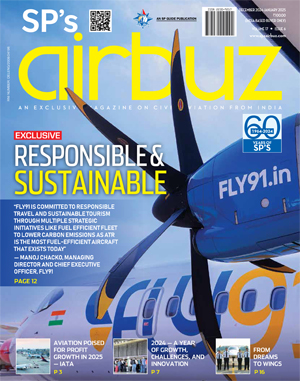Encouraging Growth

Irrespective of whether or not the government realises the need for nurturing business aviation, the latter will grow because business aircraft operators are realising the contribution of business aviation to the growth of their businesses. It is just a question of time before the establishment wakes up to this fact.
Over the last decade, airline travel in India has become more affordable, has reached the aam aadmi and its elitist image has been considerably diluted. However, business aviation has continued to be a stepchild of the Indian civil aviation industry. Traditionally perceived as having been sired by “the rich and the famous”, business aviation has been envied, begrudged, resented and maltreated. Speaking at an aviation meet organised by the Confederation of Indian Industry (CII) in New Delhi in July 2012, Tony Tyler, Director General and Chief Executive Officer, International Air Transport Association (IATA), hit the nail on the head when he said, “It is time for a grand plan to build India’s aviation future and thereby strengthen the Indian economy. For lack of a better description, what is needed is an ‘India Inc’ approach to manage interests for the widest possible benefit.” He was referring to the need for coordinated roles of the Ministries of Civil Aviation, Finance, Tourism, Commerce, Environment and Petroleum as also some others towards exploiting the full potential of aviation to benefit the national economy. From the civil aviation industry’s perspective, the current disposition is that the parent Ministry i.e. the Ministry of Civil Aviation and the other ministries concerned with civil aviation, have solely and collectively drafted policies which are unfavourable and sometimes even hostile to the industry. Unfortunately, out of all segments of the Indian civil aviation industry, business aviation continues to be the worst afflicted.
Business Aircraft Operators’ Association
Up to the year 2011, two separate organisations were working towards furthering the interests of business aviation, the Business Aviation Association of India (BAAI) and the Indraprastha Aircraft Aviation Association (IAAA). The BAAI had been formed in 2004 with the aim to take up issues concerning the business aviation community. In 2010, the IAAA was formed with similar objectives. In a significant development, the two have merged to form a new organisation, the Business Aircraft Operators’ Association (BAOA) which is doing a great service to the business aviation sector. In its endeavour to spur the growth of business aviation, it is working overtime to dispel the idea that a business aircraft is no more than a status symbol whose only role is to carry business dons and their families around. BAOA is doing its best to constantly highlight the impact of time-saving travel of executives, not necessarily of the big houses but also those of medium and small businesses, on growth of individual businesses with cumulative effect on the national economy, directly and indirectly.
Regulatory Framework
One of the areas where BAOA’s endeavours have started bearing fruit is that of the regulatory framework for business aviation that has notably been a weak area. Regulations for scheduled operations formulated by the Directorate General of Civil Aviation (DGCA) are adequate and robust. But for non-scheduled operations and general aviation, of which business aviation is a sub-set, the regulatory provisions tend to be adaptations of those drafted for scheduled operations. BAOA’s efforts have led to some changes in the existing Civil Aviation Requirements (CARs) but a lot more needs to be done in that direction. As it is not possible for BAOA to selectively pursue business aviation interests exclusively, a serendipitous and happy spin-off from BAOA’s labour is that non-scheduled operations and the rest of general aviation have also benefited. Some of the draft cars on DGCA site for public views are a result of the work by the BAOA with DGCA functionaries.
Lack of Dedicated Infrastructure
Infrastructure woes are a double whammy for business aviation. At most airports, the facilities available for business aviation aircraft are inadequate. The metros are especially hostile to a business aircraft desirous of extended parking time while the senior company executives travelling by the aircraft complete their assigned mission. If the airports had their way, they would like the aircraft to fly an empty, wasteful leg to another airport just to park and return only when its passengers are ready for departure, thus defeating the whole purpose of a quick reaction business aircraft to meet a busy executive’s rapidly changing requirements as dictated by the compulsions of his business. If the aircraft is planned to stay on, the entailed expenses for parking, are exorbitant. Indeed, the BAOA is seeking legal action against the Mumbai International Airport Limited (MIAL) for the arbitrary and high parking charges imposed on business aircraft. Even the lounge facilities, if these do exist, come at a cost that pinches every business operator. The base end operators are stung by the high cost and the high-end ones who should normally be able to afford it, also find the financial burden somewhat unreasonable on account of by their high frequency of operations.
Dedicated terminals with hangar space and parking bays for business aviation aircraft are unheard of in India. The BAOA has often stated that there is a need to revisit the infrastructural requirements as the Operations, Managements and Development Agreements (OMDAs) for most private airports state that there cannot be another airport within a 150-km radius of an existing one. Fixed base operators (FBOs) are more or less non-existent. Wherever a semblance of an FBO does exist, the dispensation is monopolistic and very high priced for the aircraft operators due to the high royalties exacted by them. Maintenance, repair and overhaul (MRO) for business aviation likewise costs a lot because of the high rates of value-added tax (VAT), service tax, customs duty and royalties to the airports they are located at.





